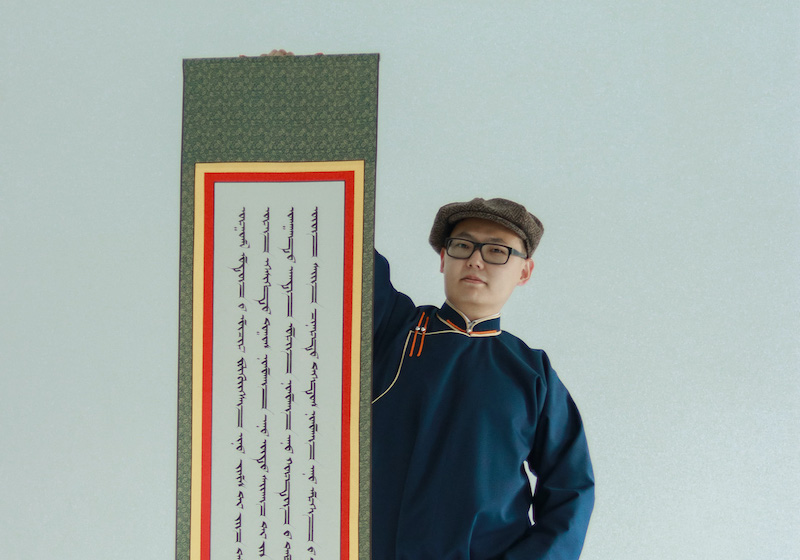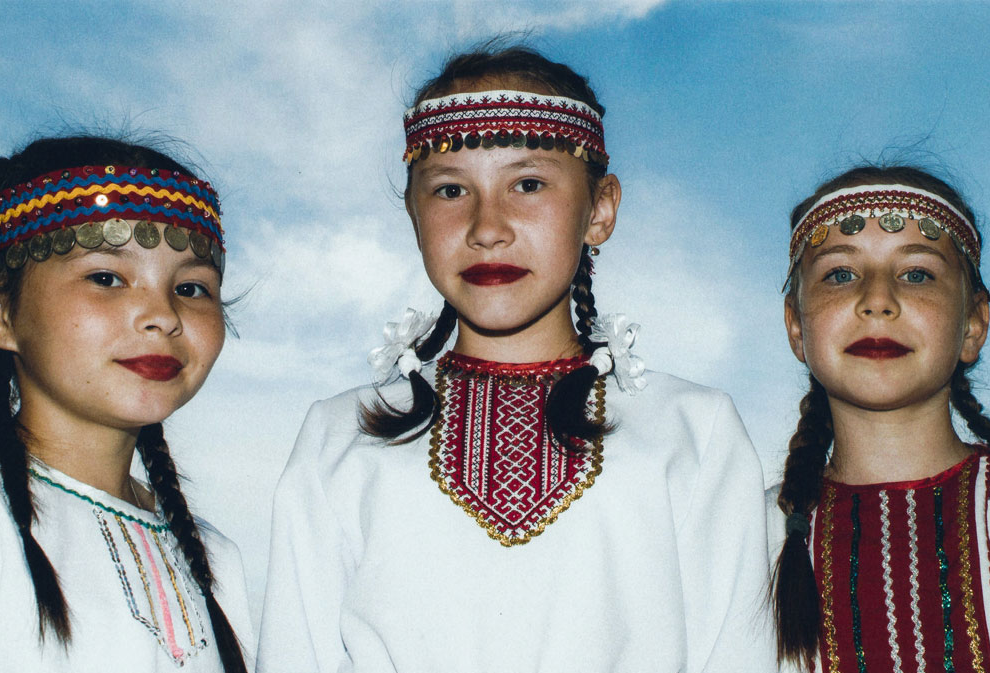The Buryat language is endangered. One calligrapher is using the Mongolian script to give it new life

Amgalan Zhamsoev was exposed to the cascading lines of the Mongolian script in Buryatia as a young child, when his mother showed him a Buryat text written in the language’s original Mongolian alphabet. He didn’t pay it much mind until a friend showed him an old dictionary written in the same script in ninth grade. It sparked a desire to learn more about Buryatia’s history, and he bought cheap brushes and ink to learn how to recreate the flowing Mongolian letters himself. He now works as a calligrapher, educator, and researcher focused on Buryat and Mongolian studies in Ulan-Ude, Russia.
In the years since Zhamsoev first started creating calligraphy, he has created a diverse body of work that is constantly evolving. A bulk of this work is what most would expect from a calligraphic piece, lines of script on a hanging scroll. Yet while his work may seem simple, the process behind his craft is extremely time-consuming. Recently, Zhamsoev has begun making his own scrolls to accompany his calligraphy, paying particular attention to how the words correspond with the color of the fabric. He also has explored the use of a number of different styles of script, including the xylographic and folded styles, discovered during his studies of the Mongolian calligraphic tradition.
A stamp created by Zhamsoev with the Buryat language written in Mongolian script.
The Buryats are a Mongolic people that have historically resided in southern Siberia near Lake Baikal. Today, the majority of Buryats still reside in Russia’s Republic of Buryatia, but of the 460,000 ethnic Buryats that live there, only about half speak the area’s original language, Buryat, fluently. The decline is partly due to a Soviet decision in the 1970s that required all schools to teach exclusively in Russian, a measure that still remains in place today, although some schools offer Buryat language and culture as an elective course.
Today, Buryat uses the Cyrillic alphabet, but this is a relatively recent phenomenon. Previously, the Mongolian script was used in the republic starting in the late 17th century. This writing system was used widely until 1931, when Soviet officials decreed that the Latin alphabet would replace the vertical script. It was later replaced by the Cyrillic alphabet, to bring it into line with Russian. However, neither alphabet fit the language well and three letters had to be added to the Buryat Cyrillic alphabet in order to account for extra sounds that didn’t appear in Russian.
The current administration continued this tradition of suppressing alternative alphabets with a law in 2002 which banned the use of any script that was not Cyrillic. It was originally passed after the Republic of Tatarstan proposed a switch to the Latin alphabet — but it also stripped away any hope that the Mongolian script could be used in Buryatia.
But while the use of Mongolian script has been legally limited, Zhamsoev still hopes he can revive interest in Mongolian calligraphy — if not through language, then through art. “I once believed that you could bring attention back to the Buryat language through beauty,” he says. “However, reviving it has been difficult because many in Buryatia just don’t seem interested. Sometimes I ask myself: ‘do people need it at all?’ But I think that the spirit of a people needs to live on. We should not forget our ancestors who have lived on this land for thousands of years.”
Zhamsoev considers his work with calligraphy to be a byproduct of his extensive research into the history of Mongolia and Buryatia, and stresses that he is a researcher first. He experiments frequently with other local methods of calligraphy from the lesser-known history of Mongolian script. His most recent experiments have been with woodblock stamps styled on artifacts from the 1700s. These woodblocks are engraved with an entirely different writing system, Soyombo, which was developed in 1686 to write foreign words from Sanskrit and Tibetan more easily, and used mainly for religious purposes. From his research, Zhamsoev was able to reconstruct the font they used and create his own stamps.
A stamp created by Zhamsoev with the Buryat language written in Mongolian script.
“This work creates a link between our modernity and the past, even though it may look like a simple copy,” he says. “I also made improvements that make the designs more appealing to the modern gaze”. Elsewhere, Zhamsoev also tries to infuse other early calligraphic practices into his work. Mongolian calligraphy is strongly tied to the development of Buddhist thang-kas, paintings depicting the life of the Buddha that are typically used for meditation. Many of Zhamsoev’s works still draw from this Buddhist tradition, as they include Buddhist mantras or pay homage to Buddhist scholars.
But Zhamsoev’s artwork also has a modern meaning. The artist hopes this historic revival will dispel some stereotypes of Buryat people as uneducated or backwards. In his own words, “In online discussions, people frequently say, ‘you don’t have your own [Buryat] script. [Russians] came to you and gave your script. You were illiterate, and we gave you culture. You should be grateful to us for that.’ This is a manifestation of the typical colonial attitude towards us,” he says. “We are bullied and then told not to complain, and not to demand that colonisers treat us in a civilized manner. The Mongolian script and active belief that it belongs to the Buryats makes us free from the bigotry of the majority.”


